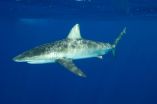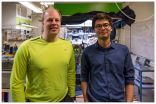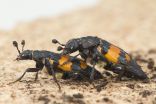(Press-News.org) CAMBRIDGE, Mass--The process of wrinkle formation is familiar to anyone who has ever sat in a bathtub a little too long. But exactly why layered materials sometimes form one kind of wrinkly pattern or another -- or even other variations, such as creases, folds, or delaminated buckles -- has now been explained at a fundamental level by researchers at MIT.
The underlying process is the same in all of these cases: Layers of material with slightly different properties -- whether skin tissue or multilayer materials created in the lab -- tend to form patterned surfaces when they shrink or stretch in ways that affect the layers differently. But the new analysis, for the first time, creates a unified model that shows exactly how the properties of the individual layers, and how they are bonded to each other, determines the exact form of the resulting texture.
MIT associate professor of mechanical engineering Xuanhe Zhao and postdoc Qiming Wang have published their findings in the journal Scientific Reports. The patterning process they describe applies to everything from the folds on the surface of the brain to wrinkles on an aging face, and from the buckling of tree bark to the ridged skin of a pumpkin.
By understanding the factors that produce these patterns, the researchers say, it should become easier to design synthetic materials with exactly the kinds of surfaces needed for specific applications -- such as better traction, or water-shedding properties. The work could also lead to a better understanding of many biological processes, Zhao says, including the growth of plants, animals, microbial colonies, and organs in the body.
"We propose a systematic approach," says Zhao, who also holds an appointment in MIT's Department of Civil and Environmental Engineering. The work began with a classification of patterns into specific categories: wrinkles, creases, folds, period doubles, ridges, and delaminated buckles.
"Wrinkles," in this scheme, have a relatively uniform wavy shape -- a sinusoidal curve -- when seen in cross-section, Wang explains, while "creases" are sharp indentations like those seen on the brain's surface. "Delaminated buckles" form when layers start to come apart, as on the bark of a tree, and "ridges" form relatively narrow, spaced-out peaks.
Then, describing each of the forms as a different "phase" of the layered material, the researchers created a three-dimensional phase diagram that shows how three basic characteristics of the layered material -- having to do with the relationship between the different materials' expansion or shrinkage, rigidity, and how tightly bonded they are -- lead to these different outcomes.
Using this diagram, Zhao says, "We can quantitatively predict which state a surface will fold into, so you can design the pattern you want." These same principles "apply to various length scales, from very small to very large," he adds.
Zhao's own research has already explored the use of such patterning mechanisms in the design of materials, such as a crumpled form of graphene that could be useful in the creation of flexible batteries and supercapacitors. But until now, such research lacked unifying principles to guide the selection of materials based on their fundamental characteristics.
"Now, we can guide the design of new patterns and functions," Wang says, "by going to a set of parameters predicted by the model."
Zhao and Wang tested their model by comparing its predictions to a wide variety of different materials in the lab and previously reported results, and found that it agreed very well with experimental data. "The surprising thing is, with so many complicated shapes, now you can just use one system, one understanding" to explain variations, Zhao says. "This is the simplest model that explains all these patterns."
The researchers expect that this model will not only be helpful for understanding growth and aging patterns in biological organisms, but could help in the design of materials for disease treatment, cell cultures, control of biofouling, controllable properties of water shedding, and flexible electronic materials.
INFORMATION:
The research was supported by the U.S. Office of Naval Research and the National Science Foundation.
March 9, 2015 -- Unhealthy weight gain in pregnancy has been linked with infant size and body composition but until now little was known about its long-term association with childhood obesity among low-income and multi-ethnic youth. For the first time, researchers at Columbia University's Mailman School of Public Health studied the effects of gestational weight gain on childhood obesity risk among a multi-ethnic urban population. The researchers determined that excessive pregnancy weight gain was associated with greater overall and abdominal body fat in children and obesity ...
EUGENE, Ore. -- March 9, 2015 -- University of Oregon geologist Qusheng Jin initially labeled his theory "A Wild Hypothesis." Now his study of arsenic cycling in a southern Willamette Valley aquifer is splashing with potential significance for arsenic-compromised aquifers around the world.
In a paper online ahead of regular publication in the journal Nature Geoscience, Jin's five-member team reports on a bacterial process that turns toxic inorganic arsenic into organic forms that usually are considered to be less dangerous. Jin's conclusion now is that organic arsenic ...
SAN FRANCISCO (March 9, 2015) -- A team of Brazilian scientists--including Luiz Rocha, PhD, Associate Curator of Ichthyology at the California Academy of Sciences--is raising awareness about impending conservation setbacks for Brazil's aquatic animals, calling for immediate fisheries management collaboration between the nation's public and private sectors. The scientists say Brazil can transform this moment of political turmoil into positive action--and become a leader among developing countries facing widespread extinction of aquatic fauna. The call to protect the future ...
Vildagliptin (trade name Galvus or Jalra) has been approved since September 2007 for adults with type 2 diabetes mellitus in whom diet and exercise do not provide adequate glycaemic control. The German Institute for Quality and Efficiency in Health Care (IQWiG) examined in a new dossier assessment whether this drug offers an added benefit over the appropriate comparator therapy. Such an added benefit cannot be derived from the new dossier either, however, because the drug manufacturer did not submit any suitable data.
Manufacturer itself applied for a new dossier assessment
Neither ...
Atomic clocks are the most accurate clocks in the world. In an atomic clock, electrons jumping from one orbit to another decides the clock's frequency. To get the electrons to jump, researchers shine light on the atoms using stabilised laser light. However, the laser light has to have a very precise frequency to trigger very precise electron jumps. It is however challenging to get the laser light frequency ultra precise - there will always be a little 'noise'. Now researchers from the Niels Bohr Institute have developed a method that reduces the noise so that it is up to ...
The drug combination of ledipasvir and sofosbuvir (trade name Harvoni) has been available since November 2014 for the treatment of chronic hepatitis C infection. The German Institute for Quality and Efficiency in Health Care (IQWiG) examined in a dossier assessment whether this new drug offers an added benefit over the appropriate comparator therapy.
IQWiG found a hint a non-quantifiable added benefit for two out of seven patient groups in total: in an infection with genotype 1 hepatitis C virus (HCV) when previous therapies had been unsuccessful, and when previously ...
HEIDELBERG, 10 March 2015 - An international group of researchers has shown that a regulatory protein involved in controlling how cancer spreads through the body also influences the fate of stem cells in the intestine of mice. The results, which are published in The EMBO Journal, show that the Snai1 protein plays an important role in deciding the fate of intestinal stem cells and the different functions that these cells can adopt.
"Our results show that Snai1 is a key regulator of crypt base columnar cells, a type of stem cell found in the invaginations or crypts that ...
New research conducted by The University of Manchester has found that GPs' patients can feel alienated by lack of trust, impersonal processes and that this presents problems to improving their safety.
Most research into patient safety focuses on the systems operated by health services. This is particularly focused on hospitals. However, most encounters occur within GP services where relationships between doctor and patient can form a significant part of reaching successful diagnosis and treatment.
The team from the NIHR Greater Manchester Primary Care Patient Safety ...
Study suggests that millions of modern Asian men are descended from 11 ancient leaders, including Genghis Khan
Sample examined the Y chromosomes of 5,000 Asian men from 127 populations
Historical nomadic and mobile populations allowed for Y chromosomes to be spread far and wide
Geneticists from the University of Leicester have discovered that millions of modern Asian men are descended from 11 powerful dynastic leaders who lived up to 4,000 years ago - including Mongolian warlord Genghis Khan.
The study, which is funded by the Wellcome Trust and published in ...
Males that mate more often are more insecure about their social status than those mating less, according to new research on the behaviour of burying beetles.
The study, published in the journal Evolution, provides new evidence that the social sensitivity of male behaviour is linked to how often male beetles mate.
Male burying beetles actively compete with each other for access to breeding resources such as dead mice, and when they find a suitable carcass will emit pheromones as a signal to attract females. But the emission of pheromones may also attract other males, ...



